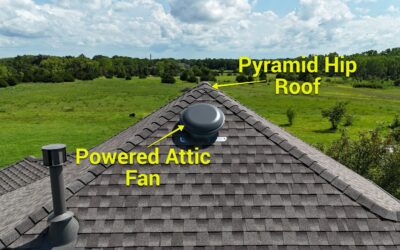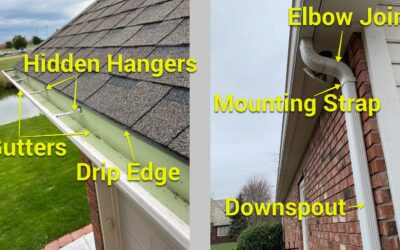What to Know About Promoting Longevity and Ensuring Structural Integrity
Your home protects you and your family, while your roof protects your home.
When you choose your roof’s material, as with most purchases, it often comes down to value: balancing performance (like durability, longevity, and appearance) with cost (both upfront and long-term maintenance). Asphalt shingles effectively balance both, which is a reason why they’re so common. Concrete tile roofs have the potential to push that value even further. With proper maintenance, they can function for up to 75 years, making them one of the longest-lasting steep slope roofing materials available.
Concrete tile roofs are not as popular today as they were in 1970-1980. Other synthetic materials have largely replaced concrete tile over the last couple of years. Despite this trend, concrete tile roofs are ubiquitous in hot, arid climates due to their resistance to UV radiation and energy efficiency.
Why Concrete Tile in Wichita Still Holds Up, and Why You Should Keep It
Given the availability and long-lasting nature of concrete, it is no surprise that concrete tile in Wichita has been such a popular choice for homeowners over the years. There are many reasons why concrete tile in particular is so beneficial. Let’s dig a little deeper and see if the benefits of tile in the 70’s and 80’s still hold up to today’s standards.
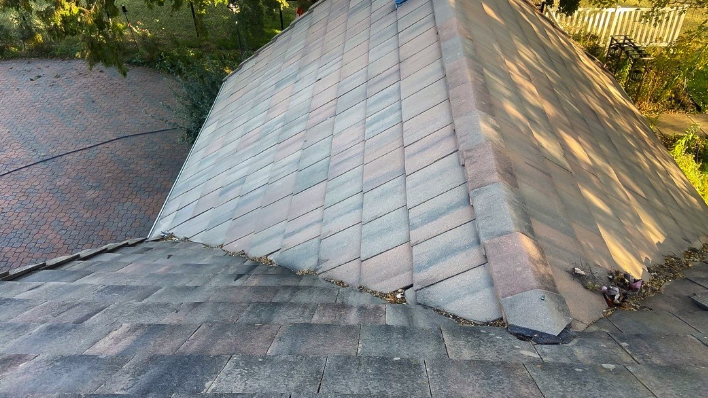
- Durability: Concrete works as your house’s foundation, With the right mix, it can protect your roof too. One reason why concrete tile in Wichita holds up as well as it does is because of its inherent resistance to the elements. Due to its material composition, Class A fire resistance, UV resistance, UL 2218 Class 4-rated impact resistance, dimensional stability and low water absorption, concrete tiles can withstand harsh Kansas weather conditions for up to 75 years with consistent maintenance. Extreme heat, heavy rain, hail, snow, and strong winds – not a problem for your foundation or concrete tile roof.
- Energy Efficiency: Concrete tiles have natural thermal properties that can greatly help in regulating indoor temperatures. It’s the same principle that adobe homes employ — thick concrete or stone has a lot of thermal mass. This means that concrete tile roofs take a long time to heat up and transfer that heat down into the attic. Concrete tile placement, uplifted by battens, allows air to flow underneath them. It’s similar to the holes on a hat that let the head breath. This results in homes being nice and warm in the cold months and cool during the summer.
- Environmental Sustainability: Concrete tile is an eco-friendly material that is composed of natural materials including cement, water, and sand. These materials are abundant and widely available. Using these regionally available materials decreases the negative environmental impact associated with extraction and manufacturing. At the end of their life, concrete tiles are recyclable, so they will be reused to produce new concrete tiles or other construction materials. Asphalt shingles largely comprise byproducts: asphalt, fiberglass, and granules of crushed stone. While these materials can be repurposed, recycling of asphalt shingle material is involved and not widely practiced. GAF, our preferred shingle manufacturer, is recycling an increasing number of asphalt shingle materials. For now, concrete tile is easier to recycle and more commonly recycled as a result.
- Increased Property Value: Durability, energy efficiency, and overall aesthetic appeal of concrete tile roofs help increase the value of a home. Concrete tiles come in a large variety of colors, styles, and textures allowing homeowners to choose whatever compliments the architectural style of their home. But how long does concrete tile last, and what goes into taking care of them in the long-term?
- Low Maintenance: Concrete tile roofs are pretty low maintenance compared to most roofing systems, resulting in less frequent out of pocket expenses to address emergency repairs. They resist harsh weather conditions, rot, decay, and insects. Of course, it’s important to make sure experienced professionals are responsible for proper installation and routine inspections to ensure longevity and performance over time. While they require less frequent maintenance than their asphalt shingle counterparts, concrete tile roofs can have more costly maintenance when it’s needed. Ultimately, concrete tile’s extended service life and infrequent maintenance make it a good investment for many homeowners. With regular inspections and the following maintenance tips, your concrete tile roof can last for 50+ years.
Tips for Maintenance of Concrete Tile Roofs
- Cleaning: Regularly inspect and remove any debris such as branches, dirt, leaves, etc. Accumulated debris can impede water drainage and contribute to deterioration of the roof, especially the underlayment. While concrete tiles can survive with or without regular cleaning, the underlayment beneath the tiles has a shorter lifespan that regular cleaning extends. Clean up any algae or moss growth using a detergent or specialized solution to prevent spread.
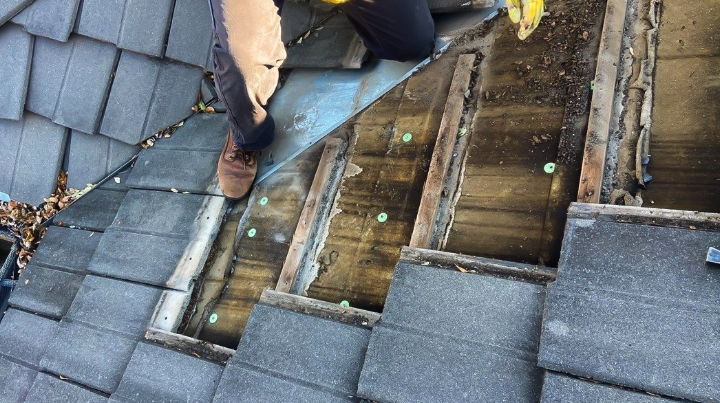
- Regular Inspections: Maintenance of concrete tile roofs includes frequent inspections to make sure everything looks the way it should including areas where two roof sections come together to form a valley where debris often collects. Check the tiles for any visible cracks, damage, or signs of deterioration. After severe weather conditions like hail, it’s best to inspect from on top of the roof for any broken or loose tiles. We highly recommend contacting a trusted and experienced roofing contractor to perform rooftop inspections, as concrete tiles are vulnerable to fractures from foot traffic.
- Flashing and Sealant Inspection: Check the flashing around any roof penetrations such as vents or chimneys to make sure it is secured correctly. If you notice signs of sealant deterioration, apply a roof sealant to maintain water resistance. Keep in mind that sealant is intended to be a redundancy — not the primary method of keeping water out of your house. If you notice penetrations that have many previous applications of sealant, it’s worthwhile to contact a professional to inspect for deficiencies that necessitate frequent sealant application.
- Preventative Measures: It is always better to manage minor concerns proactively than to fix large scale deterioration later. Sealant is a good temporary salve, but preserving the underlayment with properly integrated flashing is the permanent fix. Valleys, penetrations, and the roof’s perimeter are both the most likely locations for leaks and the areas most closely examined by roofing experts. Underlayment integrity is especially important here. If preventative measures won’t address prospective issues, it’s likely that a roofing specialist will recommend a lift and relay. This replaces compromised underlayment and battens beneath the tiles, ensuring that your roof’s waterproof layer is intact. Applying sealant is a great temporary solution for cracking, exposed fasteners, or some general wear. But a roof’s job is to keep water out of the house, so preventative measures that permanently stop water infiltration are always worthwhile.
- Professional Inspection: If you have a concrete tile roof, a roof replacement can be circumvented with regular inspections and proper maintenance. Due to the carefully rooftop navigation required to avoid damaging concrete tiles, we recommend contacting a professional for your roof inspection. Once the inspection is complete, they will make any repairs, adjustments, and provide you with expert recommendations for concrete tile roof maintenance needs for your property.
How Rhoden Roofing Can Help YOU with Concrete Tile Roof Maintenance
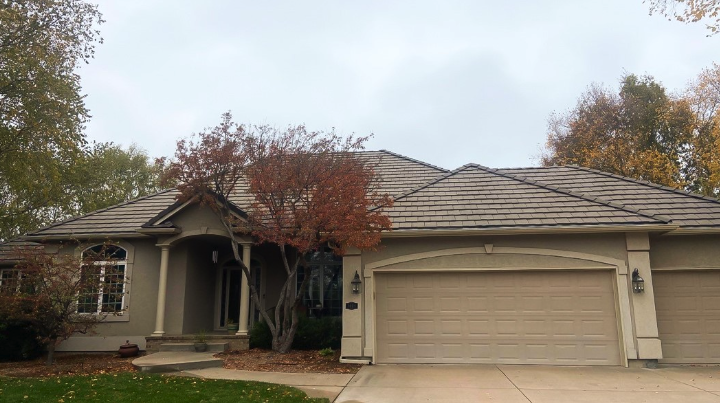
If your home already has a concrete tile roof, you have one of the most durable materials in residential roofing. Most of the homes in the Wichita area have concrete tile roofs that were installed years ago, some even dating back to 1980. Many homeowners have reported to us that they noticed issues at transition areas, like valleys, on their roof. Concrete tile roofs have a long service life, but valleys and other transition areas are still vulnerable to leaks without proper maintenance.
If it’s been ten years or more since your last concrete tile roof inspection, now is a good time to make sure the concrete tile roof maintenance has been taken care of, before simple repairs aren’t an option anymore. Rhoden Roofing offers assessments guided by years of experience with concrete tile roofs. These assessments are tailored for concrete tile systems and can help you determine whether any preventative work is needed.
FAQ
1. If I have a concrete tile roof, should I consider switching?
No. Concrete tile roofs are durable and have long lifespans. While underlayment and flashing may need attention eventually, switching from a concrete tile roof isn’t necessary unless there’s widespread structural damage or failure.
2. How do I clean and maintain my roof?
This can be done by simply removing debris, inspecting for visible damage, checking sealant and flashing, and regularly assessing the underlayment’s condition. Walking on the roof should be avoided unless absolutely necessary, as tiles can crack under pressure. Any flashing or tile inspections that require mounting the roof should be conducted by roofing professionals.
3. How do I know when it’s time to get spot repairs and seek the help of professionals?
This can vary depending on who installed the concrete tile roof and when it was installed. If your concrete tile roof was installed prior to 2015, it may not include a raised batten system. These raised battens allow both air and water to flow unimpeded. Water stopped at unelevated battens can cause wood rot, which elevated battens help to prevent. These specific batten boards have little risers on the bottom that help with proper water flow. Without them your roof is at risk of gradual leaks and rotted battens.


